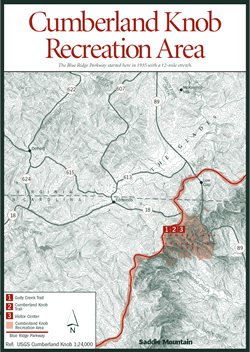 Cumberland
Knob Recreation Area
Cumberland
Knob Recreation Area  Cumberland
Knob Recreation Area
Cumberland
Knob Recreation Area [Fig. 4(2), Fig. 5, Fig. 3(5)] The world's first recreational highway, the Blue Ridge Parkway, started here in 1935 with a 12-mile stretch. Two years later, the first recreation area on the Parkway was built on this site, one of many projects carried out by the Civilian Conservation Corps. A pleasant 1,000-acre parcel, Cumberland Knob takes its name from the 2,885-foot mountain named after William Augustus, duke of Cumberland and son of King George III. Cumberland Knob Recreation Area includes a visitor contact station that stocks books and maps, picnic sites, and two hiking trails.
An easy, short walk along Cumberland Knob Trail [Fig. 5(2)] starts near the visitor center [Fig. 5(3)] and travels through woods filled with galax (Galax aphylla), flame azalea (Rhododendron calendulaceum), and rhododendron (Rhododendron catawbiense and maximum), as it gently winds toward the top, an elevation change of only 100 feet. A shelter with a rock fireplace and open areas at the top make excellent choices for leisurely picnics.
The Gully Creek Trail [Fig. 5(1)] is longer and moderately strenuous with an elevation change of 800 feet. The trail courses through a cove hardwood forest alongside Gully Creek, which flows over a series of cascades on its way through the 780-foot-deep ravine. The return trip leads hikers through patches of ferns and thickets of rhododendron and mountain laurel (Kalmia latifolia). Oak, pine, red maple (Acer rubrum), yellow-poplar (Liriodendron tulipifera), and serviceberry (Amelanchier laevis) shelter an understory of flowering dogwood (Cornus florida), smooth sumac (Rhus glabra), flame azalea, and sassafras (Sassafras albidum). The forest floor features abundant galax, houstonia (Houstonia purpurea), Venus' looking-glass (Specularia perfoliata), as well as prolific and pesky poison ivy (Rhus radicans).
Birds attracted to Cumberland Knob in late spring and summer are typical of those found in the middle elevations of the Blue Ridge province, such as downy woodpecker (Dendrocopos pubsecens), eastern wood peewee (contopus virens), eastern phoebe (Sayornis phoebe), great crested flycatcher (Myiarchus crinitus), white-breasted nuthatch (Sitta carolinensis), American goldfinch (Spinus tristis), and indigo bunting (Passerina cyanea). Also during late spring and summer, the trail along Gully Creek attracts blue-gray gnatcatchers (Polioptila caerulea), Carolina wrens (Thryothorus ludovicianus), catbirds (Dumetella carolinensis), red-eyed and solitary vireos (Vireo olivaceus and V. solitarius), hooded warblers (Wilsonia citrina), worm-eating warblers (Helmitheros vermivorus), and a few black-billed cuckoos (Coccyzus erythropthalmus). Even those who do not hike can find plenty of birding opportunities in the summer by keeping a watchful eye in the picnic and parking areas.